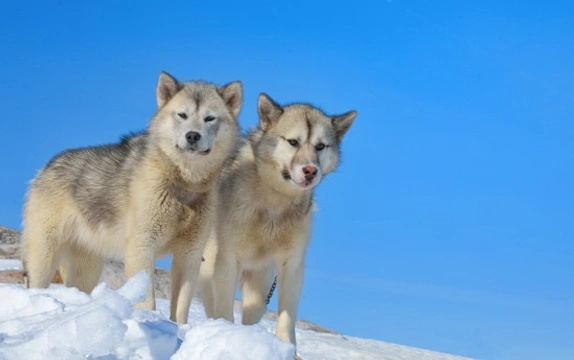
More information on the Greenland dog
The Greenland dog is also known as the Greenland husky, and as you might guess from the name, is a sled dog breed that hails from Greenland. They are widely kept today as sled dogs, and also hunting dogs to assist with hunting animals such as seals, and polar bears. They are classed as one of the most ancient dog breeds, and are thought to have been imported into Greenland in their original form by the very first Inuit settlers to immigrate to Greenland.
The Greenland dog is a strong, powerful dog that stands up to 27” tall at the withers, and has the typical spitz-type dog appearance, with a broad head, pointed, triangular ears and a tail that normally curls up over the back. Their fur is dense and thick, with two layers that consist of a short, woolly undercoat and a top layer of medium length fur that is designed to insulate and repel water.
While the Greenland dog is not as common a sight within the UK as other sled dog breeds such as the Siberian husky and the Alaskan malamute, as the popularity of sled dogs increases across the world as well as in their native lands, interest in the Greenland dog is also increasing exponentially.
If you love the look and temperament of sled dog breeds but are looking for something a little different to the more common Siberian husky, the Greenland dog might be one that is worth considering. Read on to learn more about the temperament and care requirements of the Greenland dog breed.
What are their temperaments like?
The Greenland dog is still kept chiefly as a working dog within Greenland itself, and remains very similar to the original appearance and temperament of the first dogs that formed the breed. Within their working roles, they are prized more highly for high speed and superior strength rather than a particularly good temperament for domestic life, but it is not impossible to keep a Greenland dog within a domestic situation, with some caveats. The Greenland dog requires an experienced, confident owner that is knowledgeable about the traits and challenges of sled dog breeds, and as such, they can be rather a handful, and are not recommended for first time dog owners.
However, they are also loyal, loving and very personable dogs once their respect has been earned, and are often highly protective of their homes and families.
Do they need a lot of exercise?
The Greenland dog within a working role is used to carry packs and mush over inhospitable terrain for hours at a time, and they are not happy if kept indoors for the greater part of the day within a sedentary lifestyle. Fulfilling the Greenland dog’s exercise requirements can be a challenge, and they need to spend several hours per day walking and running, with supervision and a handler available to watch them. They require both on the lead walking and being able to run freely, which means that access to a large, safe and enclosed outside area for the dog to run in is vital.
Are they easy to train?
The Greenland dog is a tenacious, intelligent and often stubborn breed that is not afraid to get into a battle of wills with their trainer, and that is very reluctant to perform tasks that they do not wish to do! Their trainer should be very familiar with the traits of sled dog breeds and be able to manage the temperament of a strong willed dog that likes to get their own way!
However, if you are able to harness the intelligence and lively nature of the Greenland dog, they can prove to be versatile, responsive dogs that can perform a wide range of tasks.
Do they have a strong prey drive?
The Greenland dog is certainly a breed that is always on the lookout for potential prey, and has a pronounced tendency to pursue wildlife and potentially cats when outside of the home. This can be one of the hardest traits to manage for the potential owner, and means that on the lead walks, potential muzzling and access to enclosed running spaces is vital.
Do they get on well with other animals?
The Greenland dog is well used to working and living as part of a pack, and they get on well with other dogs, either within the home or outside of it. They are personable and sociable with other dogs, and assuming that they are properly socialised, will not pose a problem with other dogs in the dog park.
What type of homes do they need?
The Greenland dog needs a home that understands the traits of the sled dog, and the entire family should be confident around dogs and able to manage a lively, strong willed and excitable canine. They get on well with children and love to play with them, but may become bossy with small children if allowed to! They should have access to a well fenced garden and live in close quarters to plenty of varied walking areas, and an outdoors area that they can run around in.



